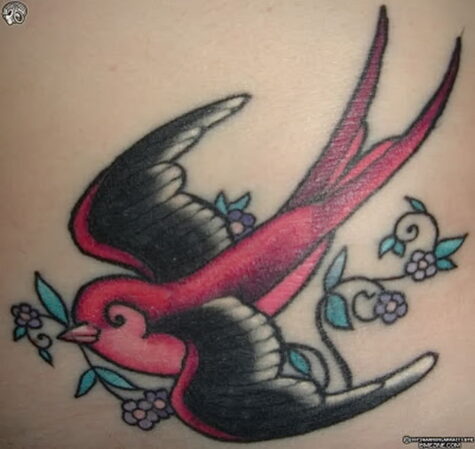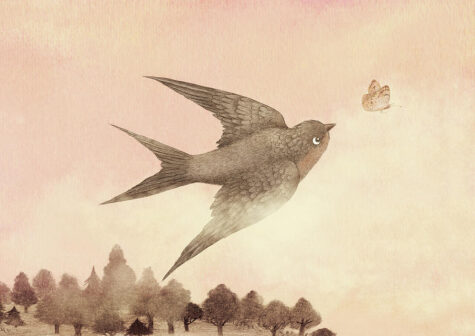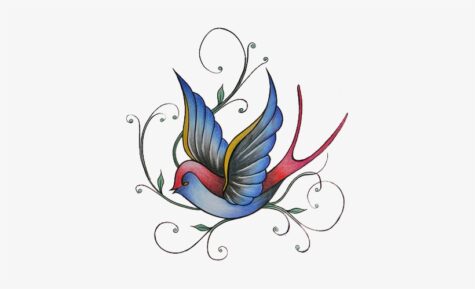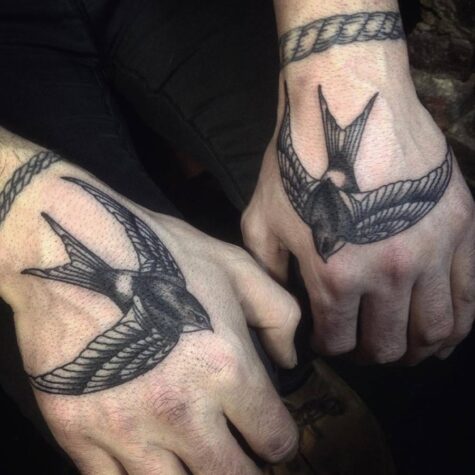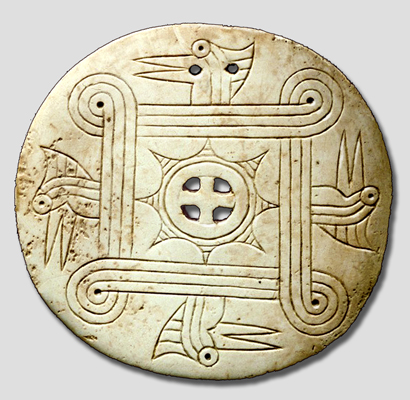Bird
The Swallow Tattoo
Having a swallow tattoo is a creative way of expressing yourself. If you are going to get one, you may want to understand what it means first. The symbolism of the swallow tattoo is cause for controversy and confusion.
Possessing a swallow tattoo symbol used to be a sign of status among sailors. The meaning behind it was that swallows, supposedly, protected the sailors from harm on their journeys.
However, a similar version of the story is that, if the sailors did die at sea, the swallow would protect their soul and carry them to heaven. Either way, the meaning is similar. It was a great comfort, as well as a status symbol, to sailors out at sea.
According to legend, after sailing for at least five thousand miles, a sailor could get a swallow tattoo symbol put on his chest, to mark the occasion. This gave him a great sense of honor and achievement. A longer version of the legend is that, when he had traveled over ten thousand miles, he was entitled to get a second swallow tattoo on the other side of his chest.
Getting a second tattoo gave sailors an enormous sense of pride and accomplishment. It also served as a sort of pictorial resume. Since traveling by ship was very dangerous during that time. Thus, it was a sign of an experienced sailor who could be counted on in a crisis.
Sailors with two swallow tattoo symbols on their chests, instead of one, were especially sought after. It meant that they had weathered many storms and gotten through many challenges. Therefore, any captain looking for new crew members was always happy to see a sailor with two swallow tattoos on his chest.
Here is one story of the origin of the swallow tattoo: there was a ship named the swallow, the men had a mutiny and the original seven mutineers had swallows tattooed on them so that they could identify each other. Out of this, two things happened:
- The authorities heard of this identification and searched for the seven sailors who got swallows.
- Their friends got swallows tattooed on them and lied about being one of the original seven to throw the authorities off the right trail.
To a sailor the swallow means a “safe return home”. Seeing a swallow is the “first sign that land is near.” Swallows are known to travel far distances out to sea during migration and would rest on boats close to shore which gave early mariners the first sign that land was indeed close by. The horizon is 12 miles from a boater’s standpoint in the ocean (more if higher up) and swallows fly further then 12 miles out.
The swallow is also known as a sparrow and was worn by the famous pirate “Jack Sparrows”. The story also goes that if a sailor with a swallow tattoo drowns; the swallows come down and lift his soul to the heavens.
The swallow is a noble bird, with a rich history. It is a symbol of honor, faith, love and hope. To sailors in olden days, it represented everything from luck to loyalty. It served as a reminder of family, friendship and honor. In modern times, the sparrow has come to have many, sometimes quite different, meanings when worn as a tattoo. Here are some of them:
- Swallow tattoos are associated with loyalty and fidelity – swallows choose a mate for life and will only nest with that bird and no other.
- They carry a message of hope, when sailors saw a swallow they knew that land was near.
- Freedom.
- It’s a symbol of good luck for adventurers and travelers who will always find their way home. The swallows return home to San Juan Capistrano every year. So the tattoos were used to say that you will always come home.
- They are a sign of loyalty and pride.
- The swallow tattoo is a sign of enduring life, love and hope. It represents enduring courage and happiness.
There also seems to be a small connection to music. Some people connected swallows with a love, respect and appreciation for music. Much like the swallows always returning to San Juan, their home. The tattoo can represent always being home when you’re within the music.
Here is what one person shared about his grandfather’s swallow tattoos:
“I grew up in a bad area in Australia and a grandfather of a friend of mine came from England. He was a very hard man and the whole family was very tough and underworld related. I remember being a kid in their house when the grandfather was there and I asked him what his tattoos meant. He looked down on me with a hard face and said in a thick English accent (they moved to Australia in the 70’s) “It means I can walk into any pub and put my hands on the bar and if anyone would want to fight, then I would fight them”.
He was a big guy and I had heard rumors of him tearing people apart. So I guess that they kind of mean courage, strength and loyalty. Oh yeah he was also a “Teddy Boy” in England, but I am not so sure what that is.”
Depending on where you grew up, and the places you hang out, swallow tattoos can also mean:
- “Live long and live hard”.
- Swallows on the back of the hands are supposed to give you faster hands, such as in a fight or at work.
- The swallow tattoo in England means “these fists fly”.
- If they’re on the backs of the hands, it means you’ll be faster and stronger in a fight. it’s mostly in Great Britain and Australia though.
- In terms of jail house tattoos, the bluebirds, swallows or sparrows can stand for white supremacy or white power.
- In Great Britain, the swallow tattoo on your hands means you’ve earned your ‘wings’ in a UK prison, i.e. you have been initiated into male-male sex rituals.
- Swallow tattoos on a man’s hands and neck originated in British prisons from the term ‘jail-bird’. They indicate that you’ve gone to prison and done your ‘bird’.
- In Scotland it usually signifies a spell in the infamous Bar-L or Barlinnie prison in Glasgow.
The swallow’s wings are so long that the bird never reaches the ground. It always flies high above everything else on earth. Prisoners are known to tattoo themselves with a swallow when they leave prison as a symbol of freedom.
Source: Gypsy Magic
The Cox Mound Gorget
The Cox Mound, or Woodpecker, gorget style is a particularly beautiful and enduring symbol of Tennessee’s prehistoric inhabitants. A gorget was a pendant, or personal adornment, worn around the neck as a badge of rank or insignia of status and was thought to be symbolic of both earthly and supernatural powers. A variety of gorget styles, or designs, are known. As a class of artistic expression, this type of artifact falls within the Southeastern Ceremonial Complex, formerly known as the Southern Cult.
Just over thirty Cox Mound-style gorgets have been found since the late nineteenth century, primarily from prehistoric Mississippian stone box graves and villages along the lower Tennessee, Cumberland, Duck, Harpeth, and Buffalo Rivers of Middle Tennessee, and the middle Tennessee River valley of northern Alabama. As a result of the frequent mortuary association of Cox Mound gorgets with certain pottery types, namely Matthews Incised, as well as other artifacts, it has been postulated that Cox Mound gorgets date to the period A.D. 1250-1450. One rich grave from the famous burial mound at the Castalian Springs site in Sumner County produced two Cox Mound gorgets.
Typically, Cox Mound gorgets were manufactured on exotic marine shell and were white in color. Other materials, such as black slate in Putnam County and human skull fragments in Hardin County, were used rarely. Engraving the intricate design on the hard shell or slate without metal tools took many hours of skilled labor and is thought to have been a winter activity.
A Cox Mound gorget has three important iconographic elements. In the center is a cross inside a rayed circle or sun motif. The cross is symbolic of the sacred, or council, fire. The sun represents the sky deity and/or mythical ancestors. Surrounding the cross and sun is a scroll-like design element known as the looped square. This feature may represent wind, or possibly the litter on which subordinates carried a chief.
Typically the looped square is composed of four lines, but in some cases only three lines are used. Four crested bird heads, which most scholars interpret as woodpeckers, are found on the outer edge. The woodpecker heads always are oriented in a counterclockwise direction, suggestive of the prehistoric Native American swastika.
The woodpecker, like the falcon, was probably a symbol of war to the prehistoric Mississippian Indians. The war symbolism of the bird probably derived from the red head of the bird, which resembled a bloodied scalping victim. The Cherokees associated the red-headed woodpecker with danger and war, and the woodpecker was always invoked for aid by the ball game players. The bird’s pecking is similar to an Indian warrior striking the war post at the Victory dance. For the Cherokees, the color red is associated with male attractiveness and fertility, as well as bravery and war. Groups of woodpeckers are thought to be a sign of war to the Creeks and Seminoles. While war is typically associated with males in Native American society, it is important to note that Cox Mound gorgets have been found in both male and female burials.
Other interpretations include the identification of the four woodpeckers as the four thunders at the world quarters, and a folklorist has speculated recently that the Cox Mound gorget style is a prehistoric expression of the Yuchi myth of the Winds. Cox Mound gorgets are displayed by the Tennessee State Museum and Pinson Mounds State Archaeological Area.
Source: Tennessee Encyclopedia
